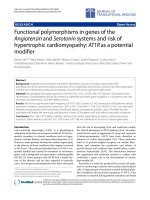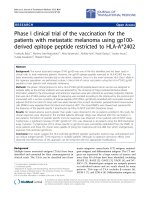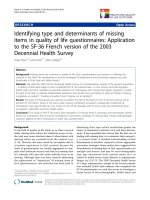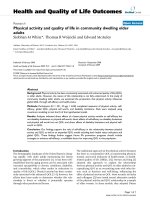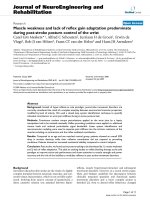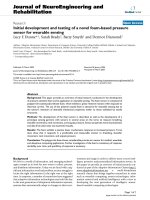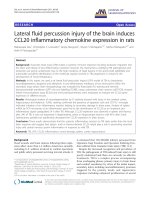báo cáo hóa học: " Muscle weakness and lack of reflex gain adaptation predominate during post-stroke posture control of the wrist" doc
Bạn đang xem bản rút gọn của tài liệu. Xem và tải ngay bản đầy đủ của tài liệu tại đây (781.56 KB, 11 trang )
BioMed Central
Page 1 of 11
(page number not for citation purposes)
Journal of NeuroEngineering and
Rehabilitation
Open Access
Research
Muscle weakness and lack of reflex gain adaptation predominate
during post-stroke posture control of the wrist
Carel GM Meskers*
1
, Alfred C Schouten
2
, Jurriaan H de Groot
1
, Erwin de
Vlugt
2
, Bob JJ van Hilten
3
, Frans CT van der Helm
2
and Hans JH Arendzen
1
Address:
1
Department of Rehabilitation Medicine, Leiden University Medical Center, Albinusdreef 2, 2333 AL, Leiden, The Netherlands,
2
Department of Biomechanical Engineering, Faculty of Mechanical Engineering, Delft University of Technology, Mekelweg 2, 2628 CD, Delft, The
Netherlands and
3
Department of Neurology, Leiden University Medical Center, Albinusdreef 2, 2333 AL, Leiden, The Netherlands
Email: Carel GM Meskers* - ; Alfred C Schouten - ; Jurriaan H de Groot - ;
Erwin de Vlugt - ; Bob JJ van Hilten - ; Frans CT van der Helm - ;
Hans JH Arendzen -
* Corresponding author
Abstract
Background: Instead of hyper-reflexia as sole paradigm, post-stroke movement disorders are
currently considered the result of a complex interplay between neuronal and muscular properties,
modified by level of activity. We used a closed loop system identification technique to quantify
individual contributors to wrist joint stiffness during an active posture task.
Methods: Continuous random torque perturbations applied to the wrist joint by a haptic
manipulator had to be resisted maximally. Reflex provoking conditions were applied i.e. additional
viscous loads and reduced perturbation signal bandwidth. Linear system identification and
neuromuscular modeling were used to separate joint stiffness into the intrinsic resistance of the
muscles including co-contraction and the reflex mediated contribution.
Results: Compared to an age and sex matched control group, patients showed an overall 50%
drop in intrinsic elasticity while their reflexive contribution did not respond to provoking
conditions. Patients showed an increased mechanical stability compared to control subjects.
Conclusion: Post stroke, we found active posture tasking to be dominated by: 1) muscle weakness
and 2) lack of reflex adaptation. This adds to existing doubts on reflex blocking therapy as the sole
paradigm to improve active task performance and draws attention to muscle strength and power
recovery and the role of the inability to modulate reflexes in post stroke movement disorders.
Background
Movement disorders after stroke are the result of a highly
complex interplay between neuronal, muscular, and con-
nective tissue characteristics, which is not yet fully under-
stood. Evolving from Lance's concept of spasticity[1], a
direct causative relation was assumed between hyper-
reflexia, muscle hypertonia/contracture and subsequent
movement disorders. However, in a recent review paper,
Dietz and Sinkjaer underline the discrepancy between
clinically measured spasticity and functional spastic
movement disorders and a more complex picture is
sketched [2]. Next to altered reflex behaviour, changed
Published: 23 July 2009
Journal of NeuroEngineering and Rehabilitation 2009, 6:29 doi:10.1186/1743-0003-6-29
Received: 2 November 2008
Accepted: 23 July 2009
This article is available from: />© 2009 Meskers et al; licensee BioMed Central Ltd.
This is an Open Access article distributed under the terms of the Creative Commons Attribution License ( />),
which permits unrestricted use, distribution, and reproduction in any medium, provided the original work is properly cited.
Journal of NeuroEngineering and Rehabilitation 2009, 6:29 />Page 2 of 11
(page number not for citation purposes)
visco-elastic properties of muscles and connective tissue
[3-7] and the role of (impaired) voluntary muscle activa-
tion [8,9] are considered important factors. Furthermore,
factors are interrelated, e.g. muscle mechanics will influ-
ence stretch reflexes [10] while changed muscle visco-elas-
tic properties may be compensatory for the nervous
system dysfunction [2,11]. Additionally, level of volun-
tary muscle activation will influence all aforementioned
factors and interrelations [9]. It is therefore not surprising
that it is still difficult to predict which patients will benefit
from antispastic treatment [12,13].
In order to improve treatment strategies, it is important to
quantify the role of both neuronal and muscular contri-
butions to the movement impairment. Mainly because of
the aforementioned interplay, this is faced with difficul-
ties. Neuronal and muscular factors are to be separated by
other means than differentiating in movement speed, as
both factors are able to generate velocity dependent joint
stiffness, i.e. viscous muscle properties and velocity sensi-
tive stretch reflexes. Furthermore, measurements should
be task defined, as passive measurements are likely not
related to the active system state [2,13]. The application of
external perturbation signals and subsequent closed loop
system identification is a powerful tool to assess systems
with an intact peripheral reflex feedback loop, as is the
case in stroke [14]. A haptic manipulator was developed
by which continuous torque perturbations can be applied
to the wrist [15]. The subject holding the handle is to resist
the resulting angular deviations maximally. These devia-
tions are kept small to allow for a linear approach. Force/
torque perturbations feel natural to the subject and trigger
all available mechanisms to generate endpoint joint stiff-
ness under maximal performance [16]. The used manipu-
lator is controlled to respond to the mechanical behaviour
of the subject attached, while the manipulator's apparent
characteristics can be set. Thus, the mechanical load to the
neuromusculoskeletal system can be manipulated [17].
The relationship between handle torque (input) and
resulting angular deviation (output) yields the mechani-
cal behaviour of the subject attached and comprises
intrinsic muscle resistance and reflex mediated stiffness.
Neuromuscular modelling is subsequently applied to
identify the muscle visco-elasticity i.e. intrinsic resistance
including muscle co-contraction and the reflex mediated
resistance, i.e. the reflexive feedback loop gain.
The goal of this study was to quantify both factors in a
cohort of patients with clinically diagnosed spasticity after
stroke using aforementioned method. In order to study
reflex modulation, two reflex provocative experiments
were performed: 1) applying additional viscous manipu-
lator loads; 2) reducing the perturbation signal band-
width.
Methods
Patients and subjects
A convenience sample of n = 13 patients with a spastic
paresis after stroke was recruited from the outpatient clin-
ics of the Rijnland's Rehabilitation Center, Leiden, The
Netherlands and the Leiden University Medical Center. A
control group was composed of age, sex and arm domi-
nance matched healthy subjects (Table 1). All patients
had a Modified Ashworth Score [18] of ≥ 2, a functional
disability (Brunstrom stage between 2 and 5 [19]) and
enhanced tendon reflexes of either the mm. flexor and
extensor carpi ulnaris or radialis on the affected side com-
pared to the ipsilateral side. All subjects gave their written
informed consent to the experiment, which was approved
by the Medical Ethical Committee of the Leiden Univer-
sity Medical Center.
Table 1: Demographic characteristics & disease history
Patient ID Age (yrs) Sex Follow up (months) Paretic side Dominant side Ashworth Brunnstrom stage
150M4 R R 2 5
252F32 L R 5 3
367F4 L R 3 4
464M8 L L 2 5
562M5 R R 2 5
676M7 L R 3 3
756M6 L R 4 3
850M11 L R 4 2
974M58 L R 4 2
10 54 F 4 R R 2 5
11 48 F 11 L R 4 2
12 64 F 312 L R 5 2
13 42 F 168 L L 3 2
Patients 58.4 ± 10.4 7ǩ6Ǩ 48.5 ± 91.2 3R 10 11R 2L 3.31 ± 1.11 3.31 ± 1.32
Controls 58.1 ± 8.6 7ǩ6Ǩ 11R 2L
Journal of NeuroEngineering and Rehabilitation 2009, 6:29 />Page 3 of 11
(page number not for citation purposes)
Apparatus
A custom built haptic manipulator was used [15], consist-
ing of a computer controlled electrical disc motor (Bau-
muller DSM 130N, Nürnberg, Germany) with a vertically
oriented handle attached to the motor axis via a lever (Fig-
ure 1). The length of the lever was such that on average,
when holding the handle, the rotation axis of the wrist
coincided with the axis of the motor. Between the handle
and the lever, a force transducer was mounted. The motor
was equipped with an encoder to measure the (joint)
angle (Stegmann SRS50, Düsseldorf, Germany).
A haptic controller was used which replaced the real
manipulator dynamics with virtual dynamics, in this case
a (rotational) visco-elastic load with inertia. This permit-
ted: 1) estimation of the mechanical characteristics of the
subjects from the mechanical behaviour of the total sys-
tem, viz. man and machine, as subjects adapt to the load
[17]; 2) adjustment of the loading conditions, i.e. inertia
(I
e
), viscosity (b
e
) and elasticity (K
e
).
The motor was mounted underneath a table, on which
surface adjustable clamps were mounted to fixate the
lower arm. The subjects were seated while the arm/shoul-
der was positioned in about 45° internal rotation with
respect to the frontal plane, with the elbow in about 90°
flexion.
Procedure
Subjects were asked to minimize displacements of the
wrist while continuous random torque disturbances were
applied to the handle of the manipulator (Figure 2). Dis-
placements of the handle were shown on a computer
screen to motivate the subjects and to control for angular
drift of the handle from the neutral position. Perturba-
tions were imposed upon the subject during trials of 10
seconds duration. Between each trial, a 5 second rest
period was inserted to avoid fatigue. The perturbation sig-
nals were off line generated and delivered twice for each
condition. Basically, two types of experiments were per-
formed, comprising different types of perturbations (Fig-
ure 3):
1) Wide Bandwidth perturbations (WB): a perturba-
tion signal with uniform power between 1.4 and 50
Hz [20,21]. Loading characteristics, i.e. I
e
, b
e
and K
e
were set to 1.6 gm
2
, 0 Nms/rad and 0 Nm/rad respec-
tively. This condition is referred to as the reference
condition. Additionally, viscous loads were applied,
i.e. b
e
of 0.25, 0.50, 1 and 2 Nms/rad. The viscosity
increases the stability margins and allows for
increased reflex gains without the penalty of oscilla-
tions and thus, increased reflex activity is expected.
2) Narrow Bandwidth perturbations (NB) between a
fixed bottom frequency of 1.4 and a variable upper fre-
quency of 3.1, 4.3, 6.7, 9.1,11.6 and 16.5 Hz respec-
tively. The loading characteristics I
e
, b
e
and K
e
were
equal to the reference condition. Decreasing the fre-
quency content of the signal and shifting signal power
towards the lower frequencies will remove power from
the natural oscillatory frequency of the wrist and
thereby enhanced reflex gains are permitted to
improve performance at the lower frequencies.
The haptic manipulatorFigure 1
The haptic manipulator. Schematic drawing of the haptic
manipulator. The subject is holding a handle, which is con-
nected via a lever to the axis of an electrical motor, which is
mounted underneath the surface of a table. The lower arm is
fixated to the table.
Block scheme of the experimental set- upFigure 2
Block scheme of the experimental set- up. General
scheme of the interaction between a subject and a haptic
manipulator. The haptic manipulator imposes a virtual, or
external, environment P. C describes the human controller,
i.e. impedance of the wrist (inverse of admittance). Torque
disturbance, d, together with the human (reaction) torque, T,
are the inputs of the external environment, resulting in angle
θ
. During postural control, the objective of the human sub-
ject (grey box) is to 'maintain position' and the internal refer-
ence angle will be constant, or zero:
θ
ref
= 0.
Journal of NeuroEngineering and Rehabilitation 2009, 6:29 />Page 4 of 11
(page number not for citation purposes)
Thus, in total 22 trials were presented. The order was ran-
domized in order to avoid anticipation.
Data processing
Signal recording and basic processing
The recorded signals, viz. the motor (wrist joint) angle
θ
(t), torque applied to the handle T(t) and the original
perturbation signal d(t) were digitally recorded with a
sample frequency of 2.5 kHz and a resolution of 16 bits.
Electromyograms (EMG) of the wrist flexors and extensor
muscles were recorded using two bipolar electrodes,
placed in the middle of each muscle belly of the mm.
flexor and extensor carpi radialis. Inter electrode distance
was 20 mm. EMG signals were amplified, band pass fil-
tered (20–1000 Hz), AD converted (16 bit resolution,
sample frequency 2500 Hz) and rectified. EMGs of the
FCR and the ECR were summed, were the FCR was posi-
tive and the ECR negative, as they operate in opposite
direction. For each condition, the signals were averaged
over the two repetitions. Data were processed using MAT-
LAB version 7.04 (The Mathworks, Natick, Massachusetts,
USA).
Non-parametric analysis
All signals were converted to the frequency domain using
Fast Fourier Transformation. Frequency Response Func-
tions (FRFs) were calculated by dividing the appropriate
spectral densities as an estimate of the joint admittance
: ratio of angle and torque per frequency. Admit-
tance is the inverse of the impedance, i.e. the resistance of
the wrist to applied torque:
ˆ
Hf
T
θ
()
Perturbation signalsFigure 3
Perturbation signals. Examples of the perturbation signals; left: Wide Bandwidth (WB); right: Narrow Bandwidth (NB).
Upper plots: time domain; lower plots: spectral densities of the signals. For the NB, one of the six applied signal bandwidths is
shown. As the power of the perturbation signals was normalized per subject, units on the y-axis are dimensionless.
Journal of NeuroEngineering and Rehabilitation 2009, 6:29 />Page 5 of 11
(page number not for citation purposes)
Joint inertia, passive muscle visco-elastic properties
including muscle (co-) contraction and spinal reflexes all
contribute to the joint admittance.
Next to the mechanical admittance, the reflexive imped-
ance was estimated:
The reflexive impedance was described by the summed
flexor and extensor EMG activity as a result of the position
deviations. As the gain of EMG is ambiguous, only the
phase of the estimated reflexive impedance was used,
which is affected primarily by the neural time delay of the
reflexes.
Along with the FRFs, the coherences for the angle
were estimated. The coherence varies between 0 and 1
where a value of 1 indicates that the relation between
input (perturbation or joint angle) and output signal
(angle of motor/joint or EMG activity) is linear and free of
noise.
Parametric analysis: neuromuscular modelling
To obtain physiological relevant parameters a neuromus-
culoskeletal model[22] was fitted on the mechanical
admittance and the phase of the reflexive impedance
simultaneously. The model incorporates wrist inertia (I),
muscle viscosity (b), elasticity (K), neural time delay (
τ
d
)
and muscle activation dynamics. A complete model
includes three reflex gains i.e. an acceleration, velocity and
position dependent component (k
a
, k
v
, k
p
). For the wrist,
we alternatively used a model including only the velocity
dependent component i.e. k
v
. The muscle activation
dynamics describe the muscle force built-up. The activa-
tion dynamics are modelled by a second order filter with
fixed parameter settings, i.e. a bandwidth of 2.17 Hz and
a relative damping of 0.75 [21] (Figure 4).
The model was fitted onto the measured mechanical
admittance and phase of the reflexive impedance by min-
imizing the following criterion function:
where and H
ref
( f ) have a normalized amplitude
of one. Only frequencies where the perturbation signal
contained power were included. Because of the large range
of the FRF gain, a least squares criterion with logarithmic
difference was used [23]. The criterion was weighted with
the coherence to reduce emphasis on less reliable frequen-
cies in the FRF and with (1+f)
-1
to prevent excessive
emphasis on the higher frequencies [21].
The express the 'goodness' of the fit, the Variance-
Accounted-For (VAF) was calculated [21]. To calculate the
VAF, simulated and recorded angle were compared. A VAF
of 100% indicates that the model fully predicts the meas-
ured angle. The VAF is reduced by signal noise and other
unmodelled behaviour.
Stability analysis
The mechanical (in) stability, i.e. the tendency to oscillate
was estimated by calculating the phase shift (phase mar-
gin) needed to reach instability of the total system of
manipulator and subject [16,24].
Statistical analysis
A repeated measurements General Linear Model ANOVA
was used to test the effects of adding viscous loads (exper-
iment 1) and changing the perturbation frequency band-
ˆ
Hf
S
d
f
S
dT
f
T
θ
θ
()
=
()
()
(1)
ˆ
Hf
S
de
f
S
d
f
e
θ
θ
()
=
()
()
(2)
ˆ
()
γ
θ
2
f
Hs
Is bs k H
ref
sH
act
s
wrist
()
=
+++
() ()
1
2
(3)
Hs kskske
ref a v p
s
d
()
=++
()
−
2
τ
(4)
Lp
f
f
Hf H f
e
f
f
Hf H
Twrist er
()
=
()
+
()
−
()
+
()
+
()
−
∑
γ
θ
γ
θθ
2
1
2
1
ln ln ln ln
eef
f
()
∑
(5)
ˆ
Hf
e
θ
()
Block scheme of the human controllerFigure 4
Block scheme of the human controller. Block scheme
of the wrist admittance, representing (the inverse of) "C" in
Figure 4. The wrist dynamics are the result of the interaction
between the intrinsic dynamics H
int
, reflexive dynamics H
ref
and activation dynamics H
act
. The visco-elasticity as a result
from co-contraction is included in H
int
, together with the
wrist inertia. Angular deviations (θ) are sensed by the reflex-
ive system (H
ref
) and result in a corrective torque. The
imposed torque (T) together with the reflexive torque act
upon the intrinsic system (H
int
) which result in the angular
deviations.
Journal of NeuroEngineering and Rehabilitation 2009, 6:29 />Page 6 of 11
(page number not for citation purposes)
width (experiment 2). Both viscous load and frequency
bandwidth were modelled as within subject factors and
control versus patient as between subject factor. A one-
way ANOVA was used to compare the phase margins of
patient versus controls. All tests were performed with an α
of 0.05 using SPSS 11.5.
Results
Signal and model validity
Averaged over all excited frequencies, signal coherence for
the patient group was 0.87 SD 0.15 during the reference
condition and above 0.95 for the viscous loading condi-
tions. For the control group, coherence was above 0.99 for
all conditions. Variance Accounted For (VAF) for the ref-
erence condition for the patient group was 75 SD 14%
versus 84 SD 6.3% for the control group. VAF for the vis-
cous loading conditions was above 91% for both patient
and control group. Averaged over all conditions of the
reduced bandwidth perturbations, VAFs for the patient
and control group were 74 SD 17% and 78 SD 12%. Com-
bining a position feedback gain k
p
with k
v
in the reflexive
model resulted in a substantial lower VAF, i.e. 56 SD 28%
and 83 SD 11% averaged over reference condition and vis-
cous loading conditions for the patient and control group
respectively. Further results of the study are based upon a
model including k
v
only.
Experiment 1: increasing the viscous loading
Figure 5 shows typical examples of the FRF of a patient
and a control subject respectively. The patient's wrist
admittance was higher compared to the control subject. In
both cases, the admittance increased at higher frequen-
cies, due to a tendency to oscillate at the eigen frequency
of the wrist (about 10 Hz). With increased damping of the
environment, the wrist admittance decreased, implicating
a stiffer joint. The phase lag with increasing frequency
resulted from the neural time delay.
On parameter level, muscle elasticity of the patient group
was significantly smaller than the control group: mean
over the reference condition and viscous loading condi-
tions: 4.71 SD 3.32 vs. 9.50 SD 2.66 Nm, between subject
effect p < 0.001, Figure 6a.
Viscous loading caused a significant increase of the reflex
gain k
v
in the control group, while this was not the case in
the patient group: within subjects effect p < 0.001, inter-
action term p < 0.001, Figure 6b. During the reference
condition, the reflex gains of patients were comparable to
healthy subjects. During viscous loading, the reflex gains
in the control group were tuned up while this was not the
case in the patient group. There were no significant differ-
ences between control and patient group concerning the
other parameters except for the phase margins which were
significantly larger in the patient group: 64 SD 14 vs. 46
SD 13°, p = 0.014, Figure 6d. The phase margins were
only evaluated for the reference condition.
Experiment 2: varying the perturbation bandwidth
The results of this experiment are shown in Figure 6c. As
can be observed, reducing the perturbation bandwidth led
to increased k
v
for the control group, while this was not
the case for the patient group (within subjects effect p <
0.001 with interaction term p < 0.001). As such, k
v
modu-
lated with perturbation bandwidth in the normal case
while this modulation was lost in the patient group.
Discussion
We used a novel approach to estimate different contribu-
tors to joint (wrist) stiffness of patients post stroke during
an active posture task. The method makes use of a haptic
manipulator to deliver torque perturbations and subse-
quent linear closed loop system identification and neu-
romuscular modelling to analyze and express joint
admittance into relevant parameters. Intrinsic stiffness of
patients post stroke was about 50% of healthy subjects.
Reflex contribution was found not to respond to reflex
provoking conditions in contrast to control subjects.
Patients were mechanically more stable than control sub-
jects.
Validity of the experimental approach
The high signal coherences justify the linear approach
used in this study. The VAF values indicate that the meas-
urements can be well described by the used model. The
VAF decrease when including the position feedback gain
justified the use of only one, velocity dependent reflexive
feedback gain into the model. This assumption can be the-
oretically underpinned: 1) considering the relatively high
eigenfrequency of the wrist, in contrast to e.g. the shoul-
der joint, the role of reflexive position feedback is rela-
tively small compared to velocity feedback; 2) the
perturbation frequencies were 1.5 Hz and higher, while
reflexive position feedback will have the largest contribu-
tion below 1.5 Hz.
Hyperreflexia or not?
Although reflex gains for patients and controls were com-
parable during the reference condition, we found no evi-
dence of functionally enhanced reflex gains in patients.
Enhanced reflex gains relative to the intrinsic characteris-
tics i.e. muscle visco-elasticity would drive the system to
instability i.e. oscillatory behaviour. By calculating the
phase margins as a parameter of system stability we found
that patients were actually more stable than controls.
Explained from optimal control theory, healthy subjects
are apparently capable of tuning their reflexive gains to
increase performance at the cost of smaller stability mar-
gins. Patients remain on the safe side and/or are not capa-
ble of this reflex tuning.
Journal of NeuroEngineering and Rehabilitation 2009, 6:29 />Page 7 of 11
(page number not for citation purposes)
Example of FRFsFigure 5
Example of FRFs. Typical examples of FRFs of a stroke patient (left) and a control subject (right) for the mechanical admit-
tance together with corresponding coherences. Upper row: gain, the solid blue line represents the reference condition, the
red dotted line the WB disturbance with a viscous load of 2 Nms/rad and the dashed black line a NB disturbance (1.4–4.3 Hz).
Middle row: phase; bottom row: coherences.
Journal of NeuroEngineering and Rehabilitation 2009, 6:29 />Page 8 of 11
(page number not for citation purposes)
Role of impaired reflex modulation
Only a few studies so far have addressed the issue of reflex
modulation in stroke. Impairment of reflex modulation
was found previously during walking [25-27].
We addressed the upper limb i.e. the wrist during mainte-
nance of posture and found patients not to adjust reflex
gains to provoking conditions. During posture mainte-
nance and reactive to changing loading conditions, con-
stantly a balance is sought between energy efficient reflex
stiffness and energy costly co-contraction [17]. In reaching
this balance, the modulation of reflex gains is a key factor.
Model studies showed that normally this modulation is
optimal to improve performance [17,28]. While subjects
seek to be close to instability and thus are making optimal
use of their reflexes, patients do not. Thus, theoretically,
optimal control of reflexes is very important, however, the
precise mechanisms as well as the implications for func-
tion need further elaboration. Besides the optimal control
viewpoint which implies instantaneous supraspinal tun-
ing of reflex gains, other mechanisms of reflex modula-
tion are imaginable. E.g. by increasing the viscous loading
or reducing the perturbation bandwidth, the velocity con-
tent of the signals is lowered, which may induce reflex
activity at the level of the reflex loop itself (spindle
dynamics or neurotransmitter release).
Main outcome parametersFigure 6
Main outcome parameters. Panel A: intrinsic stiffness (elasticity) including muscular co-contraction as a function of increas-
ing viscous load during WB perturbations for controls (black circle) and patients (open circle) respectively. The error bars rep-
resent the group standard deviations; panel B: reflex gains (kv); panel C: reflex gains during NB perturbations for controls
(black circle) and patients (open circle) respectively. The last 2 error bars (patients and controls) represent the reference con-
dition (WB perturbations, no viscous loading); Panel D: results of stability analysis: phase margins for controls(black circle) and
patients (open circle) respectively.
Journal of NeuroEngineering and Rehabilitation 2009, 6:29 />Page 9 of 11
(page number not for citation purposes)
Passive vs. active measurements
The main difference between the current experiment and
common clinical testing is the fact that we measured
under active conditions. Under these circumstances, the
paresis component will become evident. This revealed
itself by the 50% drop in intrinsic stiffness, which is the
result of passive viscoleastic properties, modified by mus-
cle co-contraction. Muscle weakness dominating over
hypertonia during voluntary movement was found previ-
ously [29-32]. The low intrinsic muscle stiffness found in
a number of patients indicates that enhanced passive joint
stiffness which is so evident under passive testing condi-
tions is masked under active conditions. Mirbagheri et al.
[33] found in studies addressing the ankle and elbow
joint, a high intrinsic stiffness and high reflex gains under
passive conditions using position perturbations.
The absence of enhanced reflex activity under active con-
ditions confirms previous findings [34-38]. According to
Burne et al [39], spasticity may be fully explained by the
inability of patients to tune their reflex activity down
together with the active muscle contraction state, thus still
exhibiting relatively high reflexes under normally relaxed
conditions. Although the absence of reflex modulation
under provoking conditions and the domination of low
intrinsic muscle stiffness in patients suggest that spasticity
is a more complex disorder, again the importance of test
conditions on the outcome is underpinned [40].
Posture vs. movement
In order to allow for a linear approach, the positional
deviations in the present study were kept small. It
appeared that including only a velocity dependent reflex-
ive feedback gain into the reflexive model was sufficient
for a good fit of the experimental data and no position
reflexive feedback was required to explain the dynamics.
Commonly, in assessment methods the joint is moved
over considerable trajectories. This will not only have pro-
found impact on the behaviour of the intrinsic visco-elas-
tic properties of muscles and connective tissue and but
also on the reflexive feedback system. Three mechanisms
may be responsible for impaired reflex activity as a func-
tion of motion trajectory. First, it is suggested that the II or
Ib afferents (respectively spindle position and Golgi ten-
don organ) are hyperactive instead of the Ia afferents
(spindle velocity) [11]. This means that hyperreflexia
would be revealed only during significant length changes
and forces of muscles. Secondly, impaired adaptation of
reflexes, e.g. due to lack in task-dependent modulation of
Renshaw cell activity [41,42] may lead to improper adjust-
ment to muscle length changes and thereby to untimely
joint resistance [26,27]. Thirdly, disynaptic reciprocal Ia
inhibition may become evident during significant joint
motion [43].
Non-linear system identification approaches are required
for non-linear conditions i.e. moving a joint over a con-
siderable trajectory. These techniques are currently being
developed by our group.
We measured in a single neutral joint position. It may be
that different characteristics are found in wrist flexion or
extension as evidence was found for operating point
dependency in spasticity [44-46].
Clinical implications
The results of the present study further underline the dis-
crepancies between outcome during passive and active
assessment. In judging post stroke movement disorders,
the information of based on clinical tests performed
under passive conditions should be applied with caution,
as mechanical behaviour may be completely different.
This was also demonstrated for balance and standing in
stroke [47].
Therapeutically, at least for improving posture and bal-
ance, reflex blocking therapy seems less appropriate, con-
sidering the reduced reflexive feedback we found during
active tasks, while further decline of muscular strength
may be very counterproductive. Instead, enhancement of
muscle strength is required. Strengthening exercises as a
part of rehabilitation programs was found to be beneficial
[48]. Further research is required to investigate whether
return of muscle strength goes with return of reflex mod-
ulation ability, or when this is not the case what the actual
limiting factor is for regaining functionality.
Limitations
It should be noted that the measured cohort of patients
was small and possibly did not cover the entire clinical
spectrum. A single joint approach does not allow for stud-
ying inter limb coordination and the influence of body
posture on reflex characteristics, i.e. postural reflexes.
These issues will be covered in future work.
Abbreviations
Ie: Manipulator inertia [gm2]; be: Manipulator viscosity
[Nms/rad]; Ke: Manipulator stiffness [Nm/rad]; I: Inertia
of the wrist [gm2]; b: Intrinsic viscosity; including muscle
(co-) contraction [Nms/rad]; K: Intrinsic elasticity (or stiff-
ness); including muscle (co-) contraction [Nm/rad]; kv:
Velocity feedback gain [Nms/rad]; kp: Position feedback
gain [Nm/rad];
θ
(t): Joint angle [degrees]; T(t): Joint
torque [Nm]; d(t): Perturbation signal (a series of random
torque perturbations) [Nm]; FRF: Frequency Response
Function; describes the dynamic relationship between
torque and angle; i.e. ratio per frequency in the frequency
domain; : Coherence as a measure of the linearity of
ˆ
()
γ
θ
2
f
Journal of NeuroEngineering and Rehabilitation 2009, 6:29 />Page 10 of 11
(page number not for citation purposes)
the angle:torque relationship. The coherence varies
between 0 and 1; a value of 1 means that at a specific fre-
quency the relation between input and output is linear
and free of noise; VAF: Variance Accounted For. Regarding
the angular position, calculated as the ratio of the simu-
lated angle to the actual measured angle, expressed as a
percentage.
Competing interests
The authors declare that they have no competing interests.
Authors' contributions
CGM carried out the measurements, performed the statis-
tical analysis and prepared the manuscript. ACS designed
the experiment, wrote the data processing software, per-
formed the data processing and edited the manuscript.
JDG assisted in data interpretation and commented on
the manuscript. EDV assisted in experimental design and
writing of data processing software. JVH assisted in data
interpretation and commented on the manuscript. FVH
conceived of the study, assisted in data interpretation and
commented on the manuscript. JHA assisted in data inter-
pretation and commented on the manuscript. All authors
read and approved of the manuscript.
References
1. Lance JW: Symposium synopsis. In Spasticity: disordered motor con-
trol Edited by: Feldmann RG, Young RR, Koella WP. Chicago: Year
Book Medical Publishers; 1980:485-95.
2. Dietz V, Sinkjaer T: Spastic movement disorder: impaired
reflex function and altered muscle mechanics. Lancet Neurol
2007, 6:725-733.
3. Sinkjaer T, Toft E, Larsen K, Andreassen S, Hansen H: Non- reflex
and reflex mediated ankle joint stiffness in multiple sclerosis
patients with spasticity. Muscle Nerve 1993, 16:69-76.
4. Sinkjaer T, Magnussen I: Passive, intrinsic and reflex-mediated
stiffness in the ankle extensors of hemiparetic patients. Brain
1994, 117:355-363.
5. Lieber RL, Friden J: Spasticity causes a fundamental rearrange-
ment of muscle joint interaction. Muscle Nerve 2002, 25:265-70.
6. Lieber RL, Runesson E, Einarsson F, Friden J: Inferior mechanical
properties of spastic muscle bundles due to hypertrophic but
compromised extracellular matrix material. Muscle Nerve
2003, 28:464-71.
7. Friden J, Lieber RL: Spastic muscle cells are shorter and stiffer
than normal cells. Muscle Nerve 2003, 27:157-164.
8. Fellows SJ, Kaus S, Thilmann AF: Voluntary movement at the
elbow in spastic hemiparesis. Ann Neurol 1994, 36:397-407.
9. O' Dwyer NJ, Ada L: Reflex hyperexcitability and muscle con-
tracture in relation to spastic hypertonia. Curr Opin Neurol
1996, 9(6):451-455.
10. Kamper DG, Schmidt BD, Rymer WZ: Effect of muscle biome-
chanics on the quantification of spasticity. Ann Biomed Eng
2001, 29:1122-1134.
11. Dietz V: Proprioception and locomotor disorders. Nat Neurosci
Rev 2002,
3:781-790.
12. Corry IS, Cosgrove AP, Walsh EG, McLean D, Graham HK: Botuli-
num toxin A in the hemiplegic upper limb: a double blind
trial. Dev Med Child Neurol 1997, 39:185-93.
13. Ada L, Vattanasilp W, O'Dwyer N, Crosbie J: Does spasticity con-
tribute to walking dysfunction after stroke? J Neurol Neurosurg
Psych 1998, 64(5):628-635.
14. van der Kooij H, van Asseldonk E, van der Helm FCT: Comparison
of different methods to identify and quantify balance control.
J Neurosci Methods 2005, 145(1-2):175-203. Epub 2005 Mar 19
15. Schouten AC, De Vlugt E, Helm FCT Van der: Design of a torque-
controlled manipulator to analyse the admittance of the
wrist joint. J Neurosci Meth 2006, 154:134-141.
16. Helm FCT Van der, Schouten AC, De Vlugt E, Brouwn GG: Identifi-
cation of intrinsic and reflexive components of human arm
dynamics during postural control. J Neurosci Meth 2002,
119:1-14.
17. De Vlugt E, Schouten AC, Helm FCT Van der: Adaptation of
reflexive feedback during arm posture to different environ-
ments. Biol Cybern 2002, 87:10-26.
18. Bohannon RW, Smith MB: Interrater reliability of a modified
Ashworth scale of muscle spasticity. Phys Ther 1987,
67:206-207.
19. Brunnstrom S: Brunnstrom's movement therapy in hemiple-
gia: A neurophysiological approach. 2nd edition. Lippincott
Cop; 1992.
20. Schouten AC, De Vlugt E, Helm FCT Van der: Design of perturba-
tion signals for the estimation of proprioceptive reflexes.
IEEE Trans Biomed Eng 2008, 55:1612-9.
21. Schouten AC, De Vlugt E, Van Hilten JJ, Helm FCT Van der: Quanti-
fying proprioceptive reflexes during position control of the
human arm. IEEE Trans Biomed Eng 2008, 55:311-21.
22. Schouten AC, Mugge W, Helm FC Van der: NMClab, a model to
assess the contributions of muscle visco-elasticity and affer-
ent feedback to joint dynamics. J Biomech 2008, 41:1659-67.
23. Pinleton R, Guillaume P, Rolain Y, Schoukes J, Van Hamme H: Para-
metric identification of transfer functions in the frequency
domain- a survey. IEEE Trans Autom Contr 1994, 39:2245-2260.
24. Maciejowski JM: Multivariable feedback design. Addison-Wesley;
1989.
25. Sinkjaer T, Mazzaro M, Nielsen JF, Grey MJ: Decreased muscle
afferent contribution to muscle activity during human spas-
tic walking. Neurorehabil Neural Repair 2006, 20:400-1.
26. Sinkjaer T, Anderson JB, Nielsen JF: Impaired stretch reflex and
joint torque modulation during spastic gait in multiple scle-
rosis patients. J Neurol 1996, 243:566-574.
27. Morita H, Crone C, Christenhuis D, Petersen T, Nielsen JB: Modu-
lation of presynaptic inhibition and disynaptic reciprocal Ia
inhibition during voluntary movement in spasticity. Brain
2001, 124:826-837.
28. De Vlugt E, Schouten AC, Helm FCT Van der: Closed loop multi-
variable system identification for the characterization of the
dynamic arm compliance using continuous force perturba-
tions: a model study. J Neurosci Meth 2003, 122:123-40.
29. Gowland C, deBruin H, Basmaijan JV, Plews N, Burcea I: Agonist
and antagonist activity during voluntary upper-limb move-
ment in patients with stroke. Phys Ther 1992, 72:624-633.
30. Fellows SJ, Kaus C, Thilmann AF: Voluntary movement at the
elbow in spastic hemiparesis. Ann Neurol 1994, 36:397-407.
31. Kamper DG, Harvey RL, Suresh S, Rymer WZ: Relative contribu-
tions of neural mechanisms versus muscle mechanics in pro-
moting finger extension deficits following stroke. Muscle
Nerve 2003, 28:309-318.
32. Kamper DG, Fischer HC, Cruz EG, Rymer WZ: Weakness is the
primary contribution to finger impairment in chronic stroke.
Arch Phys Med Rehabil 2006, 87:1263-1269.
33. Mirbagheri MM, Settle K, Harvey R, Rymer WZ: Neuromuscular
abnormalities associated with spasticity of upper extremity
muscles in stroke. J Neurophysiol 2007, 98:
629-637.
34. Rack PMH, Ross HF, Thilmann AF: The Ankle Stretch reflexes in
normal and spastic Subjects. Brain 1984, 107:637-654.
35. Lee WA, Broughton A, Rymer WZ: Absence of stretch reflex
gain enhancement in voluntary activated spastic muscle. Exp
Neurol 1987, 98:317-335.
36. Dietz V, Trippel M, Berger W: Reflex activity and muscle tone
during elbow movements of patients with spastic paresis.
Ann Neurol 1991, 30:767-84.
37. Ibrahim IK, Berger W, Trippel M, Dietz V: Stretch induced elec-
tromyographic activity and torque in spastic elbow muscles.
Brain 1993, 116:971-89.
38. Cathers I, O' Dwyer N, Neilson P: Variation of magnitude and
timing of wrist flexor stretch reflex across the full range of
voluntary activation. Exp Brain Res 2004, 57:324-35.
39. Burne JA, Carleton VL, O'Dwyer NJ: The spasticity paradox:
movement disorder or disorder of resting limbs? J Neurol Neu-
rosurg Psychiatry 2005, 76:47-54.
Publish with BioMed Central and every
scientist can read your work free of charge
"BioMed Central will be the most significant development for
disseminating the results of biomedical research in our lifetime."
Sir Paul Nurse, Cancer Research UK
Your research papers will be:
available free of charge to the entire biomedical community
peer reviewed and published immediately upon acceptance
cited in PubMed and archived on PubMed Central
yours — you keep the copyright
Submit your manuscript here:
/>BioMedcentral
Journal of NeuroEngineering and Rehabilitation 2009, 6:29 />Page 11 of 11
(page number not for citation purposes)
40. Mirbagheri MM, Barbeau H, Kearney RE: Intrinsic and reflex con-
tributions to human ankle stiffness: variation with activation
level and position. Exp Brain Res 2000, 135:423-436.
41. Katz R, Pierrot-Deseilligny E: Recurrent inhibition of alpha
motoneurons in patients with upper motor neuron lesions.
Brain 1982, 105:103-24.
42. Mazzocchio R, Rossi A: Involvement of spinal recurrent inhibi-
tion in spasticity. Further insight into the regulation of Ren-
shaw cell activity. Brain 1997, 120:991-1003.
43. Nielsen JB, Crone C, Hultborn H: The spinal pathofysiology of
spasticity: from a basic science point of view. Act Physiol 2007,
189:171-180.
44. Kamper DG, Schmidt BD, Rymer WZ: Effect of muscle biome-
chanics on quantification of spasticity. Ann Biomed Eng 2001,
29:1122-1134.
45. Mirbagheri MM, Alibiglou L, Thajchayapong M, Rymer WZ: Muscle
and reflex changes with varying joint angle in hemiparetic
stroke. J NeuroEng Rehab 2008, 5:6.
46. Li S, Kamper DG, Rymer WZ: Effects of changing wrist position
on finger flexor hypertonia in stroke survivors. Muscle Nerve
2006, 33:183-190.
47. Van Asseldonk EH, Buurke JH, Bloem BR, Renzenbrink GJ, Nene AV,
Helm FC Van der, Kooij H Van der: Disentangling the contribu-
tion of the paretic and non-paretic ankle to balance control
in stroke patients. Exp Neurol 2006, 201:441-51.
48. Ada L, Dorsch S, Canning CG: Strengthening interventions
increase strength and improve activity after stroke: a sys-
tematic review. Aust J Physiother 2006, 52:241-248.


